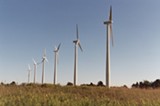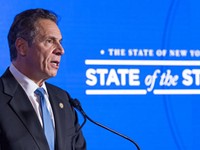[
{
"name": "500x250 Ad",
"insertPoint": "5",
"component": "15667920",
"parentWrapperClass": "",
"requiredCountToDisplay": "1"
}
]
New York leads in wind development in the Northeast, but still trails 12 other states in the country, including California, Illinois, Oregon, and Washington. Texas is eating everybody's lunch.
A burst of new wind projects could push New York higher in the rankings; emphasis on "could." Plenty of state wind-farm proposals have died due to community opposition.
And right now, a fierce fight is playing out in the Orleans County town of Yates and its neighboring Niagara County town, Somerset. That's where Apex Clean Energy proposed its Lighthouse Wind project, which calls for up to 70 turbines across a 12-mile area in the two lakeside towns.
Apex officials say the turbines could be taller than 600 feet each — meaning they'd stand above the country's current record-holder, a 557-foot tower and turbine built this summer near Des Moines.
A group of full- and part-time residents from the lakeside towns have formed to oppose the project.
"It's created kind of an all-out battle in the area," says Howard Pierce, a supporter of the wind farm who lives in Yates, just outside of the project boundary.
A decade ago, New York got a negligible amount of its power from wind. Today, however, the state gets approximately 3 percent of its electricity from turbines. That's still a much smaller percentage than it gets from hydropower (18 percent), natural gas (44 percent), or nuclear (31 percent), but the proportions will probably change over the next few years.
New York officials and utilities regulators approved an aggressive new statewide clean energy goal earlier this year, which requires half of the electricity generated in the state to come from carbon-free sources by 2030. Governor Andrew Cuomo calls it an ambitious action to fight climate change, and it will require aggressive development of renewables in New York.
The state's had a renewable energy standard since 2004, and government agencies backed it up by offering long-term energy-purchase contracts to renewables projects.
That's part of the reason why wind companies such as Apex Clean Energy, Invenergy, and Rochester Gas and Electric's parent company, Avangrid, see opportunity in the Empire State; the energy contracts provide reliable revenue for the projects, which takes some of the risk out of them and makes them easier for developers to finance.
"Knowing that the state is committed to this on a long-term basis gives comfort to the developer who's going to undertake something that may take four or more years to come to fruition," says Neil Habig, director of Northeast development for Apex.
Across the county, wind-power growth has happened in spurts, largely because Congress would pass wind-power production tax credits, let them expire, and then eventually renew them. Last year, however, Congress approved a five-year extension that gradually phases out; the thought being that as technology improves and costs drop, the subsidy will no longer be needed.
In New York, the credit adds an extra kick to state renewables efforts. Apex submitted a new wind-farm proposal to the State Public Service Commission in September: Heritage Wind would be located in Barre, an Orleans County town between Albion and Medina. It's one of six new wind projects submitted to the agency this year for review.
Apex made its initial regulatory filings on Lighthouse Wind in late 2014. It chose the Yates and Somerset location in part because it's breezy enough to make a wind farm viable; the areas along the Lake Ontario and Lake Erie coasts have some of New York's most favorable wind conditions, according to a US Energy Information Administration map.
But the area also has two other things that are just as important: plenty of wide-open land and landowners amenable to the project. So far, Apex has leases with more than 100 landowners covering 10,000 acres, says Cat Mosely, the company's public affairs manager.
Howard Pierce, who doesn't have a lease with Apex, is a renewable energy supporter with 62 solar panels on his property. And he sees two major benefits to Lighthouse Wind: tax revenue for the towns, counties, and schools; and income for farmers, particularly the struggling family operations that make up so much of Yates and Somerset.
"Lord knows we need tax relief up here in New York State," he says.
On the other side is Kate Kremer, a Brighton resident who spends summers at family-owned property in Yates. She's vice president of the Lighthouse Wind opposition group, Save Ontario Shores.
SOS objects to the project for several reasons, including familiar concerns about turbine noise and flicker. While the concerns get raised a lot, scientific research hasn't found a definitive link between the whooshing and flickering of moving blades or the low-frequency sounds from the turbine, and health impacts; Apex representatives point to a collection of peer-reviewed studies saying there's no link.
SOS members also don't like the state approval process for the projects because it takes decision-making power away from local officials and because it's so technical that it's not accessible to the average person, Kremer says. They also object to the height of the turbines, which would surpass the tallest structures in the region, she says.
"This is very much different than either the wind turbine projects that they've seen around the state, and certainly different than anything these counties have encountered," Kremer says.
SOS raises another concern. The group, as well as the Genesee Valley Audubon Society and the Nature Conservancy of Central and Western New York, say that putting big turbines so close to the lake shore could kill large numbers of migrating birds. (Scientific studies differ on the threat that turbines pose to birds.)
The turbines would be within a major songbird and raptor migratory flyway. For the songbirds, the shore and the farms along it serve as important stopover sites following overnight flights across Lake Ontario. Raptors ride currents caused by warming ground-level air to ease their trip around the lake.
"I like to say we're not against the project; we're against the poor placement of the project," says June Summers, president of the Genesee Valley Audubon Society.
Summers and local Nature Conservancy director Jim Howe say the best solution is to move the turbines back at least three miles from the shore and to make sure the proposal is thoroughly vetted for its potential impact on wildlife. If the project remains as proposed, additional measures, such as stopping the turbines during peak migration season, should be considered, they say.
Apex representatives say they're preparing detailed wildlife and turbine location studies.
Siting, in a broader sense, will continue to be one of wind power's biggest challenges. The projects take up a lot of space, and the more land any development covers, the greater the potential for conflict.
"The Nature Conservancy is very supportive of wind power, but like any energy source, we need to be very careful where it's sited," Howe says. "I think environmental considerations have to part of that siting process, as do human considerations, too."










